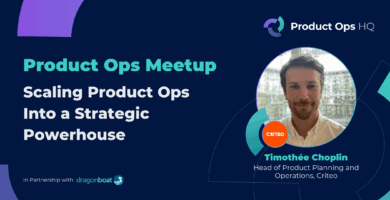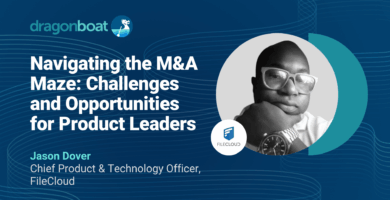Events • On Demand | Watch Time: 53 Min
2023 Strategic Planning for Outcome Focused Teams
As product teams move from feature roadmapping to outcome-driven portfolio management, strategic product planning has become an integral part of every company.
Watch this webinar with Perry Steinberg, Chief Product Officer (CPO) of AbacusNext, and Becky Flint, CEO and Founder of Dragonboat, in which they discussed how to best run 2023 strategic planning to align OKRs, strategies, and initiatives while avoiding the common pitfalls in the process.
This webinar covers how to:
- Convert business goals to product strategy and focus
- Disseminate and operationalize annual goals
- Adjust responsively to changes and new inputs
- Run annual & continuous like AbacusNext
The webinar is in a discussion format between two execs with a combined 30 years of experience building and scaling product teams across companies of all sizes in all industries. The speakers share their insights on strategic vision, tactical execution, and everything in between required for effective annual planning.
Meet your speakers:
Perry Steinberg is the Chief Product Officer at AbacusNext, a cloud-based tech provider for legal and accounting firms. Perry is an innovative technology and product leader, with a track record of success building and leading teams to deliver new products and experiences that result in higher user engagement and improved operational efficiency.
Becky Flint built and scaled product portfolio management at PayPal, Bigcommerce, Shutterfly and Feedzai. She is the founder of Dragonboat, an integrated product portfolio platform that helps product teams strategize, prioritize, deliver and improve industry-leading products.
Transcript
The following transcript has been altered for readability.
Becky Flint: It’s all too familiar when we find our teams are facing the challenges of no strategic alignment and no guidance. That’s why today we’ll focus on strategic planning best practices.
I am so happy to have Chief Product Officer (CPO) of AbacusNext, Perry Steinberg. Perry, I would love to hear some of your thoughts on your experience in various-sized companies.
Perry Steinberg: I’ve had the pleasure and excitement of working with extremely large companies, as well as small private equity and VC-backed companies that have somewhere between 50 and $100 million in revenue before joining AbacusNext as Chief Product Officer.
At the highest level, some challenges exist. It’s this misalignment of allocation of resources to core objectives that the leadership is trying to achieve. And when we think of strategic planning, what we’re starting to do is focus on the OKRs of the business. We want to align the allocation of the organization to what those OKRs consist of. And that’s something that is a challenge. It’s actually something that is a huge focus of mine as a product leader. And I’m excited about leveraging Dragonboat to push that strategic planning capability through the organizations.
Becky Flint: When I first began strategic planning we weren’t able to move the needle on what we wanted to do because everyone was scrambling. So we couldn’t deliver all the initiatives that we promised or planned in the strategic planning process. So this is something that we had to change.
One big change was that instead of doing just budgeting exercises, we looked at how people could be shuffled around to support these initiatives.
Perry Steinberg: Let me give you two examples.
One is what I’m going through right now with AbacusNext. As you had mentioned, we’re roughly a $100 million private equity company. And as you described, historically organizations were pushed from the CFO on down. And there was a disconnect between what those numbers were and how sales viewed their quotas. There was also a disconnect on their ability to drive revenue and how product management historically viewed the development efforts. And now we’re in the process of going through an alignment around our business goals to hit our revenue number. What are the objectives and key results that we’re trying to obtain from initiatives and projects?
And those projects are then tied to specific features that are being developed in an allocation. So we’re able to build that process, not only from the top-down but also from the bottom-up. We want to see exactly where we’re spending our resources. Well, it’s more of an outcome-based approach, rather than just something that we’re going to be working on. We want to focus on those outcomes of the business. So now, the revenue and development teams need to get aligned, as we think about the next phase of what we’re trying to develop. And that development is directly tied to the projects, initiatives, and goals of the organization. So it’s something that I’m excited about, it’s something that I’ve pushed throughout all my organizations.
On the flip side of that, I’ve seen in my last larger organization business lines operated slightly differently. We saw a big disconnect between the business lines that I ran working with the revenue teams. That was to generate outcome-based approaches to key objectives for that year, and over the next three-year period. And we achieve those objectives because everyone is pulling in the same direction. Whereas another business line, which was very much a top-down, CFO-driven exercise, didn’t achieve the business objectives. That was because that business unit was not aligned around achieving revenue targets, and what was being developed.
That lack of alignment eventually was identified as a key reason why the core business unit objectives were not met. So thinking about it from a top-down and bottom-up perspective makes a big difference to the eventual outcomes.
Becky Flint: Quite often when thinking of a business versus a product there’s generally a misalignment especially in a technology industry.
One of the companies I joined, never did strategic planning with our r&d team or product team. So that was the first time we went through that exercise. And so what we ended up doing is we got everyone to get in a room and write on a piece of paper what they want in their function? When we flipped our paper open, that’s when we realized that everyone has different ideas, right? That was eye-opening for the organization to say, “well, if we were to go all those routes nobody’s gonna go everywhere, because everyone’s gonna ask the product team to build different features.
So the hardest part was actually for us to all agree on how we double our revenue. It was one of the most painful sessions but also a very productive session. We were able to decide how to spend our resources. That conversation was around just understanding everyone’s perspective. And in the end, we aligned the entire business.
Perry Steinberg: One of the things you hit on that resonates for me and I’m sure other Chief Product Officers, is the conversations from an executive perspective on resource allocation. And as we think about new markets, what percent of our dollars should go to which key effort? That’s why we want alignment around that from an executive perspective. We want to understand where we’re trying to go. And what percentage of our effort is going just to keep the lights on? That’s why it’s great to have this theoretical model of 20 60 20.
This is a conversation that I’m having with the companies that I’ve worked at in the past. I tell them models give an understanding of where we’re spending our dollars today. That then allows us to make adjustments. It allows you to change the trajectory of your team to get more into our target allocation. And to do that, you need to have an understanding of exactly where you’re at today for a good strategic alignment and strategic planning conversation.
Becky Flint: I think you’re spot on. Interestingly, one of the things that we did at PayPal in earlier days was try to understand the cost of development. And we want to understand how much of them keep the lights on and how much were feature development. That way as the years go on, there’s a proportion of the effort that was still contributed to the previous features. The numbers were staggering some way higher than 20%. But it gave us a couple of insights on how much we should plan for allocation if we build a new product.
So having that understanding is so important. The leadership team needs to create that kind of strategic clarity and alignment. Otherwise, the team will never be successful. They just don’t have direction. They don’t have the resources they need to do what they need to do. And that leads to another huge change, which is that shift from annual planning to quarterly strategic planning.
Perry Steinberg: Something that I’ve encouraged my product teams to do is to work on a monthly and a quarterly basis. Now when we look at what we want to be building over the next quarter, we’ll meet regularly so we can steer the product on an ongoing basis. So we always stay aligned. Having those monthly and quarterly product steering committees are critical. And that needs to feed into this ongoing executive on an annual basis.
Becky Flint: Right. And that would just further confirm if we need to adjust where we are going and how we are going to go there. And that’s also how new products are born. If you always just do incremental improvements and optimize and get customer feedback, nothing wrong with the customer feedback, but the customer can only see this far, you see much further what the product can do. So I think that’s interesting. How do you see a new product in your experience?
Perry Steinberg: Yeah, I think that’s a good point. On the previous slide, you had one area that said, strategies. And one of those strategies is what is the customer mindset? What is the customer focus? What is the competitive landscape that is going on in the marketplace? I have three or four big competitors that I’m worried about, but it’s not necessarily about those competitors. It’s also about those 3 4 5 little tiny competitors that we don’t necessarily look at on a day-to-day basis. But they’re going to come up and eat our lunch.
That’s why you need to understand the competitive landscape. The customer-centric views of what we’re trying to achieve are critical. As we think about this allocation, the strategies from a customer competitor and market landscaping perspective go into achieving our goals. And product leaders need to facilitate that within the whole organization to make sure that we tie back the resource allocation to the strategies with everyone’s mindset.
Audience Q&A
Bhaji Illuminati: Starting from the beginning, how big should the company be to start strategic planning?
Perry Steinberg: Actually, that was a conversation that Becky and I had in a slightly different context, we were looking at the way VC-run companies view their world, private equity companies view their world, and larger public companies view their world.
Every size company needs to look at it in this manner, the questions are going to be different in the market landscape and the rapid development of a particular market is going to differ. But even the smallest companies need to have this thought process in mind to make sure that we’re placing the bets in the right spot. As soon as you get one customer, as a tiny company, you’re going to have that customer making demands, what percentage of your resources should be dictated by that one customer versus where you want to go? So I think you need to continuously think about it, regardless of what size you are, just the questions are going to be different.
Becky Flint: Strategic planning is not a big heavyweight process, it’s more of a type of thinking. What we try to do is regardless, the company size, you always have a small set of goals. With those three or five goals, figure out the strategy on how you’re going to achieve those goals. And that should be happening to every single company, every size, not only at the executive level. What is my product goal concerning company goals and the product in the market? And the customers I need to serve? What are the goals I’m gonna focus on next quarter? The whole process of strategic planning is focused on those goals, how to achieve them, and how you’ll allocate them.
Perry Steinberg: Becky, one of the things that you mentioned that I want to make sure that I touch on for all the product leaders, CPOs, SVP of products, etc. who are watching this, is what I mentor my product managers to focus on. I tell them that if the product manager is not looking from a strategy perspective, then the product manager is not able to create the right vision, incentives, and motivations for the people on their team.
The engineers are down in the code. They focus on those features, tasks, and stories. And a lot of times when I’m mentoring people within my product team during skip-level meetings, I make sure that I’m talking about those business objectives of why we’re doing this. Otherwise, there’s going to be a lack of motivation on the engineering team. And if you’re not a product manager, spending time doing that with your engineering team you’re not doing your job right. And that goes for everyone that I mentor up through the organization. It is important to not just pay lip service, but to firmly believe it as a leader, as a product manager, as a product director, etc to be able to articulate that is critical.
Bhaji Illuminati: That ties into another question that came through. What do you see companies doing wrong during strategic planning? What are some pitfalls that people should avoid as they’re going through this practice?
Becky Flint: So there’s traditional strategic planning done at a lot of traditional manufacturing companies, and it’s very top-down. But the modern world is different now, you cannot apply the manufacturing age of strategic planning to today. Today, you want to involve the team to be part of the process and create a continuous process. The biggest mistake is to do it once a year. That’s not gonna work anymore, you have to involve the team.
Perry Steinberg: The other piece, I think that’s spot-on is level setting with data. I think that a lot of times, different leaders come to the table with different sets of facts and different sets of understanding of the data. And then you end up spending all this time within your strategic planning, meeting, arguing about the data.
Instead, in preparation for strategic planning for this ongoing week, month, quarter annually processes, grounding yourself in data that everyone understands and believes is critical.
Bhaji Illuminati: I love that. Okay, so the next question is have you run any workshops with executives to align on strategic planning objectives? And if so, what were some activities which facilitated the conversation successfully, and helped people align on strategic goals?
Perry Steinberg: The short answer is yes.
Early on in my career, we went through this big strategic planning exercise. We set up very specific swim lanes, and those swim lanes were led by individual business leaders across different functions. And so I’ve modeled, my whole career after this thought process of, from a strategic planning perspective, we need to have the buy-in. That way I could bring people to the table and say, “here’s what we need to achieve. And here’s why we’re going to achieve it”. Then we can set up the specific swim lanes with specific business leaders to get their buy-in. And once you have the buy-in to the leadership, it makes things flow that much smoother. If you don’t have the buy-in from the top, this process is extremely hard to run. But that’s how you get the objectives and the outcomes that you’re shooting for.
Becky Flint: I think that having alignment and buy-in and also executive leaders to be the tiebreaker is super important. I saw strategic planning with no tiebreaker. There’s no sort of overarching rotor orchestra. The process is, you get to do XYZ, I get to do ABC, then we call it a day, and then just go to the team to execute obviously. That’s a disaster because there’s no alignment on our strategy and low alignment on how we achieve the scores.
Instead, it’s more of just making everyone happy because we allocated resources to each individual or function versus working collectively. Strategic planning is a process to bring different viewpoints, dependencies and needs in one place where we can figure out how we work together. And then we work out a general agreement- here’s where we’re going to go. Then we can figure out for the rest of the team how they can achieve their goals.
Bhaji Illuminati: You guys were talking about allocation as they relate to pet projects earlier so here’s a question related to that. How much should you allocate to pet projects or other things that come up that wasn’t planned?
Perry Steinberg: There are two things I think about. Is it a pet project? Or is it keeping the lights on and customer-driven impact? In my mind there’s a mental target, mental model, 20% allocation, add it to that bucket. And then understanding where you’re at today, and understanding where that’s at. I think that that’s one kind of target number that I always keep in the back of my mind.
The key here is to focus on where your resources are allocated. And at that point, it’s not necessarily a pet project, per se, you’re doing it for a specific outcome, a specific business objective, is it pure innovation? Then it’s not so much of a pet project, it’s more of achieving the outcome that you’re trying to target. And that’s where I think a 20% allocation is from a target perspective, very interesting to see where your company is, with where you are at with your current allocation.
Becky Flint: Right, it’s a really good question. And I think it varies across based on the state of the business. Even in the same company, a different product at different stages of adoption would probably mean different allocation, for sure. And there’s one thing I want to emphasize when thinking about pet projects versus innovation. Because I feel like if you are thinking about innovation or it’s just a test to learn something then we want to plant our seeds.
Sometimes the pet project gets political and it’s something one person believes in so strongly and nobody else believes in so they try to hide it under the hood. That’s never good because the more you make information available and explain to people the rationale, the better you can get support and insights into information. And that kind of concept of the pet project becomes a little bit different. So I would say if it’s innovation, if it’s investing in new opportunities, companies should almost always have some allocation to it. But if it’s a pet project, it’s hidden and this is just one person who wants to do it, then allocation should be zero.

Featured Speakers

Becky Flint
Founder and CEO of Dragonboat
Becky is a product and tech executive based in the Silicon Valley. She has built and scaled product and engineering teams globally for both startups and Fortune 500 companies. Currently Becky is the Founder and CEO of Dragonboat with a mission to empower responsive leaders and their teams to build better products faster. Prior to founding Dragonboat, Becky has held executive roles at Feedzai, Bigcommerce, Tinyprints/Shutterfly, and PayPal.

Perry Steinberg
Chief Product Officer at AbacusNext
Is the Chief Product Officer at AbacusNext, a cloud-based tech provider for legal and accounting firms. Perry is an innovative technology and product leader, with a track record of success building and leading teams to deliver new products and experiences that result in higher user engagement and improved operational efficiency


